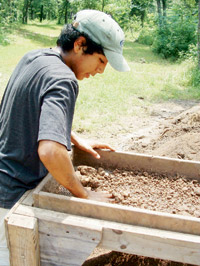
For the second consecutive summer, experts with UA’s Alabama Museum of Natural History led an archaeological expedition of the state’s first territorial capitol, Old St. Stephens in Washington County. They dug up new details about the boom town and how early Alabamians lived.
The camp was held in four sessions where researchers investigated the remains of Old St. Stephens, now a ghost town. During three decades, beginning in the early 1800s until its decline in the late 1820s, Old St. Stephens was the location of a Spanish fort, an American fort and Choctaw Indian trading post, and the territorial capitol of Alabama.
One of the structures within the ghost town, the Globe Hotel, has been a focus of the group. Participants assembled dozens of artifacts, including coins, smoking pipes, utensils, glassware, musket balls and more than 50 restorable ceramic vessels.
“Until recently, there was only speculation about where the buildings were located and how they might appear,” said Randy Mecredy, assistant director and education outreach coordinator at the museum and leader of the program. “Some of the artifacts that were discovered this summer provided solid evidence to confirm that the structure was, in fact, the Globe Hotel. Other evidence proved that there are two more structures that were located behind the Globe and that they were occupied until the late 1840s.”
The museum began this annual field science expedition with professional and academic archaeologists in 1979. Originally designed exclusively for high-school students, teachers and parents, the Museum Expedition now accepts any history, science or archaeology enthusiast who wishes to learn excavation techniques, lab procedures and artifact identification. The program remains one of only a few in the country to provide a hands-on science dig to participants as young as 14.